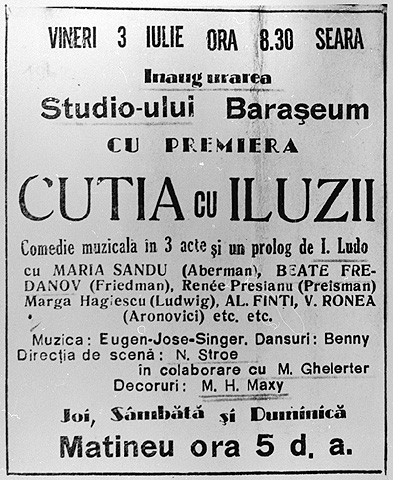
In the autumn of 1940, after King Carol's abdication, the fascist government of Ion Antonescu came to power, and the new racist legislation stipulated the removal of Jews from all institutions of the performing arts.
Jewish artists reacted to this legislation by submitting a request to establish a Jewish theater that complied with all the demands of the Romanian authorities, and although an ally of Nazi Germany and pursuing his own strongly anti-Semitic policy, the fascist government of Antonescu agreed.
On 1 March 1941 The Romanian authorities allowed the establishment of the Baraşeum Jewish Theater by means of a state license, issued on January 17, 1941. The state allowed the existence of one Romanian language Jewish theater, that is, a theater where only Jews could perform and where the racial laws of 1940 specified who was Jewish. Thus the Baraşeum created a place of employment for some two hundred artists from the fields of music, literature, poetry, theater and the plastic arts.
During the war years, the Baraşeum premiered over thirty productions, most of them revue performances, about half of them directed by Sandu Eliad. Although officially exclusively Jewish, some Romanian intellectuals helped the company illegally, especially with translations, and some showed support by coming to performances. The shows were in Romanian, but many Yiddish words were added to the text, so that even if only symbolically, the Yiddish language was kept alive .
The repertoire included classic Yiddish theater pieces such as the Dos Groise Ghivens (The Big Lottery Ticket), based on a story by Shalom Aleichem, S. Ansky's Dybbuk, new plays, and works by authors like Offenbach e and Verneuil. They also presented Romanian translations of light musicals such as "Khantshe in America" as well as new revues that had some critical relationship with their current situation, such as "What are you doing tonight?", "Spring in Do Major”, "From one Joke to the next", "Different Money, Different Entertainment" and "Hello Barasheum". Israil Bercovici, director of the State Jewish Theater between 1955-1982, wrote that during this period, the Jewish theater was pushed to the periphery, but turned it into a center of Jewish culture and art.
Romanian Yiddish actors that were deported to camps in Transnistria, especially in the camps of Mogilev, Zhmerinka, and especially in Vapniarca, continued to perform. Jewish actors from Bessarabia and Bukovina—primarily from the theaters of Cernauti and Chisinau, among them well-known figures as Sevilla Pastor, Baruch and Leah Rintzler, Mishu and Sali Bernstein, and Moshe and Rosa Siegler. In Vapniarca, the actors Asia Derevici, Littman Wigder, Beniamin Wilner and Herman Stolper presented evenings of folk songs and poetry recitations, both classic and of their ow work, and organized occasionally performances in secret or by bribing officials. The rationale was that it was a prayer meeting. A group of Young Yiddish writers, most of them Romanian, put on amateur productions of Ansky's "Day and Night" and other plays.
On August 23, 1944 the overthrow of Antonescu, led to the re-legalization of the use of the Yiddish language. The Baraşeum returned to performing in Yiddish, and the first performance, Nacht-Tog (Night-Day) by S. Ansky took place on August 23 in Botoşani— the town where, in 1876, Avram Goldfaden had presented one of the first professional Yiddish language productions, the first ever in an indoor theater.
Israil Bercovici, O sută de ani de teatru evreiesc în România (One hundred years of Yiddish/Jewish theater in Romania), 2nd Romanian-language edition, revised and augmented by Constantin Măciucă. Editura Integral (an imprint of Editurile Universala), Bucharest, 1998, 195-201
For the text of the Decree Law No, 2650 of August 8 , 1940, see Lya Benjamin ed, Evreii din Romania intre anii 1940-1944, 46
Nahma Sandrow , Vagabond Stars: A World History of Jewish Theater Syracuse University Press, 1996, 337-349
Randolph L. Braham, Tragedy of the Romanian Jewry, New York Columbia University Press, 287-331
Schumacher Claude, ed., Staging the Holocaust: The Shoah in Drama and Performance, Cambridge University Press, 1998, 1-9